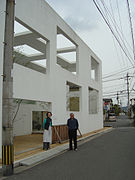Sou Fujimoto
Sou Fujimoto | |
|---|---|
藤本 壮介 | |
 (2009) | |
| Born | 1971 (age 49–50) Hokkaido, Japan |
| Nationality | Japanese |
| Alma mater | University of Tokyo |
| Occupation | Architect |
| Organization | Sou Fujimoto Architects |
| Website | www |
Sou Fujimoto (藤本 壮介, Fujimoto Sōsuke, born 1971) is a Japanese architect.
Born in Hokkaido in 1971,[1] he graduated from the University of Tokyo in 1994, and established his own office, Sou Fujimoto Architects, in 2000.[2] Noted for delicate light structures and permeable enclosures, Fujimoto designed several houses, and in 2013, was selected to design the temporary Serpentine Gallery pavilion in London.[3]
Fujimoto published a book in 2008 called Sou Fujimoto: Primitive Future.[4] It contains an overview of his projects up to that date, and it explains his concept of primitive future and how he uses it in his work.[4][5]
Career[]
After establishing Sou Fujimoto Architects in 2000, Fujimoto went on to design buildings across Japan and Europe.[6] Many of his designs are built around his idea that the function of a building is decided by human behavior.[7] In 2019, Fujimoto was selected as one of 23 architects to "reinvent" Paris.[8] His contributions to this project include a redesign of a plot in the 17th arrondissement of Paris.[8]
Selected works[]
- Final Wooden House, Kumamoto, 2005–08
- Children's Centre for Psychiatric Rehabilitation, Hokkaido, Japan, 2006[9]
- T House, Gunma, Japan, 2006-2010[9]
- N House, Oita, 2008[10]
- House before House, Utsunomiya, 2009[11]
- Tokyo Apartment, Tabashi-ku, Tokyo, 2006-10[12]
- Musashino Art University Museum and Library, Tokyo, Japan, 2010[13]
- Toilet in Nature, Chiba, Japan, 2012[9]
- House K, Nishinomiya, Hyogo, Japan, 2011-2013[14]
- Serpentine Gallery Pavilion, London, 2013[15]
- Bus Stop in Krumbach, Austria, 2014[16]
- Naoshima Pavilion, Naoshima, Kagawa, Japan, 2016 [17]
- L'Arbre Blanc, Montpellier, France, 2017 (est.)[18][19]
- House of Hungarian Music, Budapest, Hungary, 2021 (est.)[9][20]
- Mille Arbres (A Thousand Trees), Paris, France, 2016-2022 (est.)[9]

Final Wooden House

N House

House before House, Utsunomiya

Serpentine Gallery Pavilion, London
Awards[]
- JIA New Face Award, 2004[5]
- International Design Competition for the Environment Art Forum, 1st Prize, 2004[5]
- Wooden House Competition, Kumamoto, 1st Prize, 2005[5]
- Architectural Review Award Grand Prize, 2006[21]
- Kenneth F. Brown Architecture Design Award, 2007[5]
- Japanese Institute of Architecture Grand Prize, 2008[5]
- Wallpaper Design Award, 2009[21]
- Marcus Prize for Architecture, 2013[21]
References[]
- ^ "Exclusive interview: Sou Fujimoto". Gaku-gei Cafe (in Japanese). Studio OJMM. January 2011. Retrieved 23 February 2013.
- ^ El Croquis Nr.151: Sou Fujimoto 2003-2010 Archived 2016-03-03 at the Wayback Machine
- ^ Wainwright, Oliver (18 February 2013). "Sou Fujimoto's Serpentine pavilion promises a breath of fresh air". The Guardian. Guardian News and Media Limited. Retrieved 23 February 2013.
- ^ a b "Sou Fujimoto: Primitive Future". Designers & Books. Retrieved 20 October 2019.
- ^ a b c d e f "Sou Fujimoto Architect | Biography, Buildings, Projects and Facts". Famous Architects. Retrieved 20 October 2019.
- ^ "Sou Fujimoto | Japanese architect". Encyclopedia Britannica. Retrieved 20 October 2019.
- ^ "Biography of the architect: Sou Fujimoto". Floornature.com (in Italian). Retrieved 20 November 2019.
- ^ a b says:Feb 08, Daniel Zollinger; 2016 (4 February 2016). "sou fujimoto among 23 architects chosen to 'reinvent' paris". designboom | architecture & design magazine. Retrieved 20 November 2019.CS1 maint: numeric names: authors list (link)
- ^ a b c d e "Who is Sou Fujimoto?". Japan House London. Retrieved 10 November 2019.
- ^ de zeen magazine, 19 January 2012
- ^ Detail nr. "»House before House« in Utsunomiya", 2009
- ^ El Croquis Nr.151: "Tokyo Apartment" Archived 2012-02-03 at the Wayback Machine, retrieved 26 February 2013
- ^ "Sou Fujimoto Architect | Biography, Buildings, Projects and Facts". Famous Architects. Retrieved 10 November 2019.
- ^ "Complementary opposites". domusweb.it. Retrieved 6 January 2015.
- ^ Serpentine Gallery Pavilion 2013 by Sou Fujimoto, 20 October 2013
- ^ "Bus Stop Krumbach Projekt Info". Gemeinde Krumbach (in German). Retrieved 26 June 2018.
- ^ Setouchi Triennale 2016 Artwork No. 005 Naoshima Pavilion, 28 September 2016
- ^ Karissa Rosenfield. Sou Fujimoto-Led Team Designs Tree-Inspired Housing Tower for Montpellier. ArchDaily, 7 March 2014
- ^ Focus Magazine. L’Arbre blanc à Montpellier. Focus Magazine, Montpellier (in French)
- ^ https://www.dezeen.com/2021/01/20/sou-fujimoto-house-of-hungarian-music-liget-budapest-project/
- ^ a b c "Sou Fujimoto". Swiss Architectural Award. Retrieved 20 October 2019.
External links[]
- Japanese architects
- 1971 births
- Living people
- People from Hokkaido
- University of Tokyo alumni



